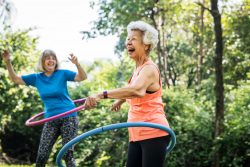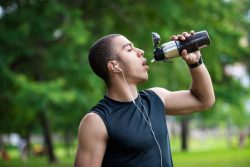Where You Live May Have An Effect on Your Longevity
 There are certain locations in the US that seem to have a significant impact on longevity of seniors. Where a person lives and not just how they choose to live, can make a huge difference. This was discovered by an innovative study which examined seniors across the US and concluded that some places enhance longevity more than others.
There are certain locations in the US that seem to have a significant impact on longevity of seniors. Where a person lives and not just how they choose to live, can make a huge difference. This was discovered by an innovative study which examined seniors across the US and concluded that some places enhance longevity more than others.
The study showed that when a 65 year old person moves from a metro area in the 10th percentile of locations that enhance longevity to a metro area in the 90th percentile it will enhance longevity by an average of 1.1 years. That is an important boost since live expectancy for a 65 year old in the US is 83.3 years. Where an older person lives is important in relation to life expectancy and mortality in the US.
Research have observed important US regional variation in life expectancy and credited it to “health capital” which includes smoking, obesity and other behavioral factors in the regional population. By analyzing the impact of moving the recent study can quantify and isolate the effect the location has on its residents.
The research delivers valuable new information about large scale drivers of health outcomes in different locations. One clear possibility is available medical care. Other possibilities include pollution, climate, traffic safety, crime and a variety of other factors. The goal was to separate out what the role of senior’s previous behaviors and experiences were, or health capital, from the role of environment or place.
The study analyzed Medicare records from 1999 to 2014 with the focus on US residents between the ages 65 and 99. The team studied 6.3 million Medicare beneficiaries. Almost 2 million of them moved from one US commuting zone to another, and the rest were samples from a random 10% of seniors who had moved over the 15 year study.
The central elements of this study involved seeing how different seniors who were originally from identical locations did when they moved to different destinations. The plan was to take different people from a given area and compare some moving to a low mortality location and others to a high mortality location. The seniors health conditions and Medicare records include detailed claims data so the team applied records of 27 different conditions and illnesses ranging from diabetes to cancer to depression.
The study discovered that many urban areas on the West and East Coasts have positive effects on the longevity of seniors who moved there. Some Midwestern metro areas also scored well. In contrast, a belt of the deep South showed negative effects on longevity for seniors. This included much of Arkansas, Alabama, Louisiana, and northern Florida. Much of the Southwest fared similarly poor.
The researchers estimate that health capital will account for almost 70% of the difference in longevity in areas across the US and that location effects account for almost 15% of the variation. Health capital is important, but location also matters.
The life expectancy of an area’s population is not the same thing as that area’s longevity effect. In areas where smoking is high, population wide longevity of survival could be subpar. But there are other factors that could make it a location where people of average health live longer. The question becomes why?
The hard evidence is in regards to the location. The next step in the research is to think about specific factors that are at work. They know something about specific locations, but don’t know what. They are now working on two studies about practices in health care to see what can be observed that would impact these location-based differences might have. One of the studies will focus on doctors and the other will look at the opioid epidemic.
To view the original scientific study click below:
Place-Based Drivers of Mortality: Evidence from Migration



 Standard scientific opinion has blamed weight gain on an excess of calories which is due to burning fewer than taken in. In opposition to this viewpoint, the carbohydrate-insulin model shows that the quality of diet matters more than calorie intake for weight loss. The model’s position is that eating processed carbohydrates and starchy foods leads to changes in hormone and insulin levels which results in an increase in fat deposition.
Standard scientific opinion has blamed weight gain on an excess of calories which is due to burning fewer than taken in. In opposition to this viewpoint, the carbohydrate-insulin model shows that the quality of diet matters more than calorie intake for weight loss. The model’s position is that eating processed carbohydrates and starchy foods leads to changes in hormone and insulin levels which results in an increase in fat deposition. Researchers who have previously discovered a method that turns skin cells into primitive like muscle cells that can be left in a lab indefinitely without losing their potential to turn into mature muscle, have now discovered how this method works and also what molecular changes it prompts within cells.
Researchers who have previously discovered a method that turns skin cells into primitive like muscle cells that can be left in a lab indefinitely without losing their potential to turn into mature muscle, have now discovered how this method works and also what molecular changes it prompts within cells.  Following a two year study of participants who ate a handful of walnuts every day showed lower levels of LDL(low density lipoprotein) cholesterol when compared with the participants levels at the start of the study. They also showed a reduced total cholesterol. The study was assisted from a grant by the Calfornia Walnut Commission.
Following a two year study of participants who ate a handful of walnuts every day showed lower levels of LDL(low density lipoprotein) cholesterol when compared with the participants levels at the start of the study. They also showed a reduced total cholesterol. The study was assisted from a grant by the Calfornia Walnut Commission. Recent research involving more than 30,000 heart patients has shown that becoming active in later life can be almost as beneficial to surviving as ongoing activity.
Recent research involving more than 30,000 heart patients has shown that becoming active in later life can be almost as beneficial to surviving as ongoing activity. If you are someone who makes mistakes or are forgetful when you are in a hurry, a recent study from Michigan State Univ. has discovered that meditation could help in becoming less prone to error. The team tested how meditation that focuses awareness on thoughts, feelings and sensations or open monitoring meditation, alters brain activity in such a manner that has suggested increased error recognition.
If you are someone who makes mistakes or are forgetful when you are in a hurry, a recent study from Michigan State Univ. has discovered that meditation could help in becoming less prone to error. The team tested how meditation that focuses awareness on thoughts, feelings and sensations or open monitoring meditation, alters brain activity in such a manner that has suggested increased error recognition. A new study has challenged what scientists in general believe about cognitive function including executive function, reasoning skills, and attention decline as people age. The new study has suggested that executive functioning and orienting actually improve with age.
A new study has challenged what scientists in general believe about cognitive function including executive function, reasoning skills, and attention decline as people age. The new study has suggested that executive functioning and orienting actually improve with age. Consuming a hot dog could actually cost a person 36 minutes of living a healthy life, while consuming a handful of nuts could help a person gain 26 minutes of an extra healthier life. A study looked at more than 5,800 foods and ranked them by the nutritional disease that can burden humans by their consumption and also the impact they make on our environment.
Consuming a hot dog could actually cost a person 36 minutes of living a healthy life, while consuming a handful of nuts could help a person gain 26 minutes of an extra healthier life. A study looked at more than 5,800 foods and ranked them by the nutritional disease that can burden humans by their consumption and also the impact they make on our environment.  A new study has shown that by staying very hydrated throughout your lifetime, you could be reducing your chance of developing heart failure. The study has suggested that keeping great hydration can possibly prevent or at the very least slow down changes that reside in the heart that ultimately lead to heart failure.
A new study has shown that by staying very hydrated throughout your lifetime, you could be reducing your chance of developing heart failure. The study has suggested that keeping great hydration can possibly prevent or at the very least slow down changes that reside in the heart that ultimately lead to heart failure. According to a new study from Binghamton Univ., just practicing meditation studies for eight weeks can make a person’s brain quicker. People all around the globe look for mental clarity by practicing meditation inspired by and/or following the age old Buddhism practices.
According to a new study from Binghamton Univ., just practicing meditation studies for eight weeks can make a person’s brain quicker. People all around the globe look for mental clarity by practicing meditation inspired by and/or following the age old Buddhism practices.